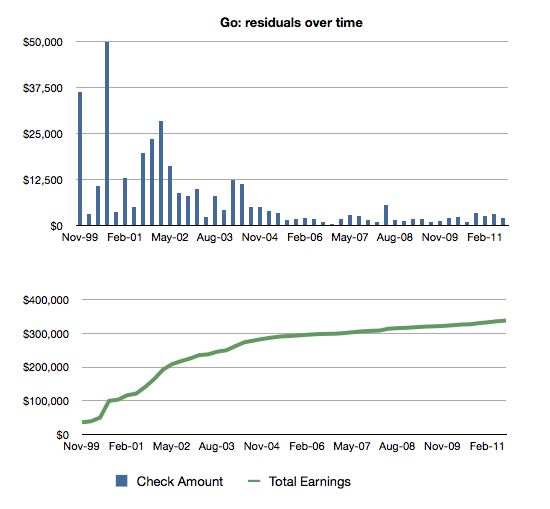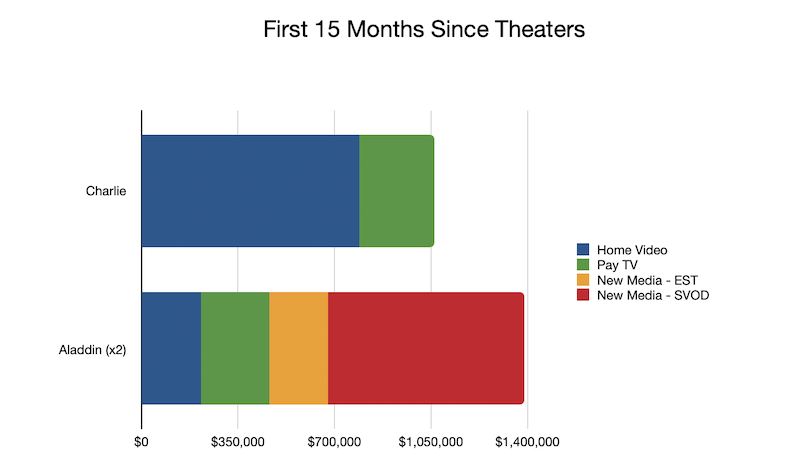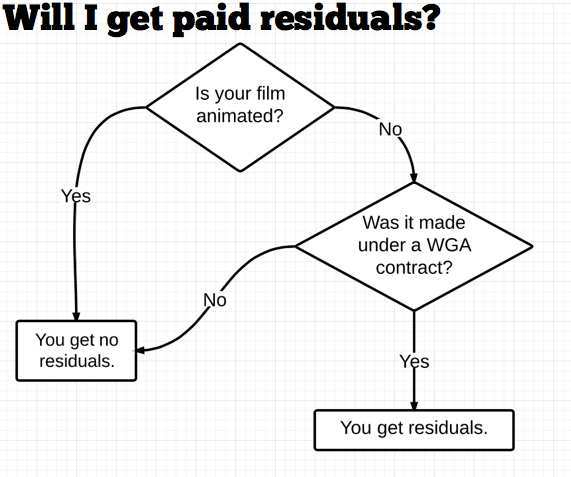Following up on my earlier post, here’s an update on Aladdin’s residuals.
Let’s look at the breakdown for 2020 Q3:
| Re-Use Market | Amount |
|---|---|
| Basic Cable | $1,536 |
| Foreign Free TV | $8,071 |
| Home Video/DVD | $11,161 |
| Pay TV | $76,687 |
| New Media — EST | $11,134 |
| New Media — SVOD | $222,496 |
| TOTAL | $331,086 |
Note that these are total writer residuals. As Aladdin’s co-writer, I get half, so I’m simply doubling what I see in my individual residuals report.
The first four categories are pretty self-explanatory. You can find more information about them in the WGA’s residuals survival guide.
New Media — EST stands for Electronic Sell-Through. This is when a customer purchases a download, which they then own forever. If you buy a movie for $19.99 on iTunes, that’s an EST. It’s the digital equivalent of someone purchasing a DVD at Target. The residual is calculated as 0.36% of the company’s accountable receipts.
The final category is a little confusing. Even after serving on the negotiating committee for the last MBA, I ended up emailing a colleague at the Guild for clarification.
New Media — SVOD combines very two different ideas. The full title for this category should really be something like New Media — Rental and SVOD. ((And even that’s not complete: this category also includes “Premium VOD,” which hasn’t really been a thing but might become more important.))
Rental is what you think. If you’ve ever paid $1.99 for a movie on iTunes and had 48 hours to watch it, that’s an electronic rental. The residual is calculated at 1.2% of the studio’s accountable receipts.
SVOD stands for Subscription Video on Demand, services like Netflix, Disney+ and Hulu, also referred to as streamers. The residual is calculated as 1.2% of the amount the studio receives for licensing the movie to the service. For example, MGM might license an old James Bond movie to Amazon Prime for 12 months. The screenwriter would get a residual based off the price MGM was able to charge.
In the case of Aladdin, it’s available exclusively on Disney+. Disney is never going to license it to Netflix or Peacock or Amazon Prime. So any fee Disney-the-studio is charging Disney-the-streamer is really just numbers on a spreadsheet. They’re the same company.
Now you’re asking: Wait, if this residual is 1.2% of a made-up number, how do you know it’s a fair price?
Self-dealing is always a concern, and has long been an issue in television. My colleague at the Guild writes:
When that happens the MBA requires the company to impute a license fee based on comparable pictures. This is an issue happening across all the streamers and is one of our most important enforcement efforts.
For 2020 Q3, this lone residual was worth nearly a quarter of million dollars for Aladdin. It’s both hugely important and largely opaque.
I don’t have a breakdown to show how much of this line item came from rental versus the imputed license fee, but it’s something I’ll be watching closely in the years ahead.


